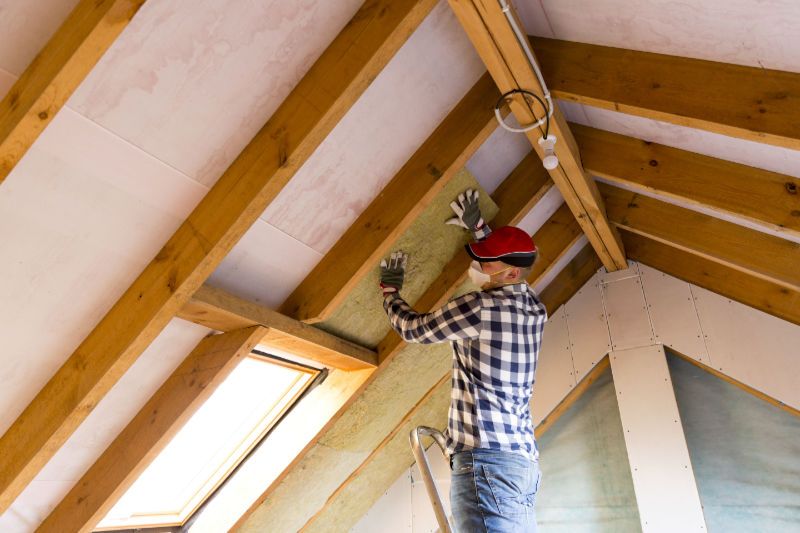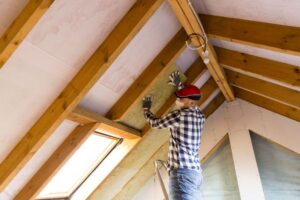How to Improve Ceiling Insulation for a More Efficient Home

When it comes to improving the energy efficiency of your home, one area that often gets overlooked is the ceiling. Proper ceiling insulation is a key factor in regulating indoor temperature, reducing energy costs, and maintaining a comfortable living environment. In fact, heat loss through the ceiling is one of the most significant sources of energy inefficiency in homes. Whether you’re dealing with a drafty attic, an unfinished ceiling, or simply want to upgrade your current insulation, enhancing ceiling insulation is a smart and effective way to improve your home’s overall efficiency.
In this article, we’ll explore the importance of ceiling insulation, how to assess your current situation, and the best ways to improve it for a more energy-efficient home.
Why Ceiling Insulation Matters
Ceiling insulation acts as a barrier that prevents heat from escaping during the winter and from entering during the summer. Without sufficient insulation, your heating and cooling systems must work harder to maintain the desired temperature in your home, leading to higher energy bills.
In addition to energy savings, proper ceiling insulation:
- Helps maintain consistent indoor temperatures
- Reduces the need for constant heating and cooling
- Prevents moisture buildup and mold growth
- Improves indoor air quality by minimizing drafts and air leakage
Whether your home has an attic or flat ceilings, improving insulation can make a significant difference in your comfort and energy costs.
Signs You Need to Improve Ceiling Insulation
Before jumping into the improvement process, it’s essential to assess your current ceiling insulation. Here are some signs that your insulation may need upgrading:
- Uneven temperatures: If some rooms in your home are consistently colder or warmer than others, it’s a sign that your ceiling insulation may not be performing as it should.
- High energy bills: Noticeable spikes in heating and cooling costs can be an indication of heat loss or gain through the ceiling.
- Ice dams: In cold climates, ice dams forming on your roof may be a result of poor attic insulation.
- Drafts or air leaks: If you feel cold air seeping through the ceiling or attic, it’s likely that insulation is lacking or settled.
- Mold or moisture issues: Inadequate insulation can lead to condensation, which creates the perfect environment for mold and mildew growth.
If you’ve noticed any of these signs, it may be time to improve your ceiling insulation.
How to Improve Ceiling Insulation
1. Assess Your Current Insulation
Start by determining the type and condition of the insulation currently in place. Common types of ceiling insulation include:
- Fiberglass Batt Insulation: Often installed between ceiling joists, this is a traditional and affordable option. However, it can lose its efficiency over time if it settles or becomes damp.
- Spray Foam Insulation: Offers superior air sealing and higher R-values, but it’s more expensive. Spray foam can be applied to gaps, cracks, and seams in the ceiling, providing excellent coverage.
- Loose-Fill or Blown-In Insulation: This type of insulation is ideal for attics and hard-to-reach areas. It’s blown into the space between the ceiling joists and fills all gaps and voids.
- Rigid Foam Boards: Rigid foam insulation is often used in attics and is an excellent option for providing a high R-value in a thin, easy-to-install layer.
Once you’ve identified your existing insulation type, check for any signs of damage such as mold, sagging, or compression. If your insulation is in poor condition or is too thin, it’s time to upgrade.
2. Add More Insulation
The most straightforward way to improve ceiling insulation is to add more material. The recommended R-value (a measure of thermal resistance) for attic insulation varies depending on your climate, but most homes benefit from an R-value of 30 to 60 for ceilings and attics.
Steps to Add Insulation:
- For attics: If you have access to your attic, adding additional layers of insulation is an easy way to increase the R-value. Blown-in insulation works well for this purpose.
- For flat ceilings: If you don’t have an attic, insulating the space above the ceiling can be more challenging but is still possible. Adding batt or spray foam insulation between the joists or inside the ceiling cavity is a good option.
- Layering: If you already have some insulation in place, you can often add another layer on top of it. Make sure the new layer runs perpendicular to the old one to eliminate gaps.
3. Seal Air Leaks
Even with ample insulation, air leaks can undermine the effectiveness of your efforts. Cold or hot air may still seep through gaps and cracks in your ceiling or attic. To ensure your insulation works efficiently, you’ll need to seal air leaks.
How to Seal Air Leaks:
- Caulking: Use caulk to seal gaps around light fixtures, vents, pipes, and any other openings in the ceiling.
- Weatherstripping: Apply weatherstripping around the edges of attic doors, access hatches, or ceiling vents to prevent air leakage.
- Foam Sealant: Expanding foam sealant is a great option for sealing larger gaps around ceiling fixtures and attic access points.
4. Insulate Attic Access Points
If you have an attic, the access point can be a significant source of heat loss. Ensure that attic doors, hatches, or pull-down stairs are properly insulated to prevent drafts. A simple way to do this is by adding an attic stair insulator or covering the attic hatch with a thick, insulated blanket.
5. Consider Radiant Barriers for Warm Climates
In warmer climates, radiant barriers are a great option for reflecting heat away from your home. These barriers can be installed in your attic to reduce heat absorption from the sun, helping to keep your home cooler. Radiant barriers are typically made of reflective foil and can be laid directly on top of existing insulation.
6. Hire a Professional for Advanced Insulation
While DIY ceiling insulation upgrades can be effective, some situations may require professional assistance. If you have a large attic, complex rooflines, or are dealing with significant air leakage, a professional insulation contractor can help you determine the best approach and ensure proper installation.
Additionally, if you’re considering spray foam insulation or need to seal hard-to-reach spaces, it’s best to consult an expert.
Final Thoughts
Improving ceiling insulation is one of the most cost-effective and impactful ways to increase your home’s energy efficiency. By ensuring that your ceilings are properly insulated, you can reduce energy waste, lower your utility bills, and maintain a more comfortable living environment throughout the year.
Remember to assess your current insulation, add more if necessary, seal air leaks, and consider professional help if needed. With these steps, your home will be better equipped to handle temperature changes, saving you both money and energy in the long run.





